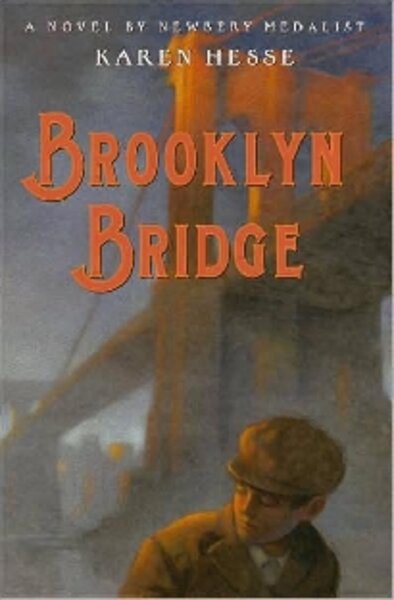Brooklyn Bridge
Loading...
In her first novel in more than five years, award-winning author Karen Hesse rewards fans and new readers with Brooklyn Bridge, an imaginative look at immigrant life in early 1900s New York City. Once again, Hesse takes readers into a carefully researched world of historical fiction, brimming with details that make the past and her characters come alive.
This time she infuses her tale with chilling elements of fantasy and imagined tragedies that seem all too real.
Fourteen-year-old Joe Michtom was just an ordinary Joe until his parents invented the stuffed teddy bear. Now his suddenly successful parents – hardworking Russian immigrants – work relentless hours to meet the demand for their unexpectedly popular invention. Their already cramped apartment gets over-run by mohair cuttings and a letter from President Theodore Roosevelt hangs on the wall next to their framed citizenship papers.
Joe introduces himself with, “The guys say I’m lucky. That I got everything. They’re right. I am lucky. I am the luckiest kid in the world. Not everyone’s so lucky. I know this.”
His adolescent musings might be as simple as wishing for the old days when his friends treated him just like anyone else and when his parents had time for “yakita, yakita” with free-thinking Uncle Meyer.
But an undercurrent of deeply troubling stories emerges throughout Joe’s tale, giving his life more depth and complexity than can be seen on the surface.
The summer of 1903 finds Joe watching his drooling baby brother rather than playing stickball and yearning to experience the thrill of the new Coney Island amusement park, “the blazing, brilliant jewel shining in the dark.” He experiences his first romantic crush, visits with his three eccentric aunts, and helps his sister set up a “home library” for their neighborhood.
But through the parallel stories of street children who live under the bridge and the “Radiant Boy” who haunts them, Hesse orchestrates a high level of intrigue.
Curiosity over how the disturbing and sometimes even gruesome stories of these homeless children will intersect with Joe’s story will keep readers turning the pages until late in the night.
In “Brooklyn Bridge” Hesse explores the duality of human experience, portraying success as mixed with hardship, contrasting a close, loving family with remnants of broken families, and interrupting moments of delight with tides of profound sadness “like the wineglass wrapped in white cloth” at a Jewish wedding ceremony “to remember that even in times of joy, life holds sorrow.”
Replete with metaphor, like the bridge itself, the novel spans this duality with the strength of a master writer, conveying to readers that past and present are inextricably bound. Under the bridge we find hope amid squalor and compassion among those who have experienced the worst cruelty, and, like the silent benevolent teddy bear, we learn with Joe that giving of oneself without recognition or recompense can be the greatest success in life.
(“Brooklyn Bridge” is recommended for readers ages 10 and up, but parents should know that some of the incidents it recounts could be troubling to younger readers.)
Enicia Fisher writes about children’s books.






